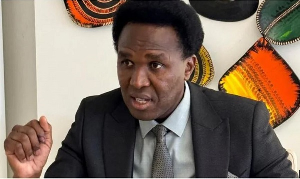A partner at KPMG, Anthony Sarpong, has challenged institutions of higher learning in the country to churn out students who can be trained to fit into the job market.
The comments come at a time it has been estimated that almost half of the 10 million graduates churned out of the over 668 universities in Africa yearly do not get job.
Mr. Sarpong thus expects the country’s universities in particular to give industries people with the right attitude, and who can take on responsibilities. He added: “A person who can develop initiatives and someone who can focus, if you have such a person -- irrespective of the background -- you can turn the person into any professional that you desire to be”.
Speaking at this year’s UGBS Business House Junior Common Room (UGBS BHJCR) event in collaboration with African Intellectual Consult (AIC, UG), Mr. Sarpong urged universities to deepen collaboration with industry players in order to pass out students who can easily be retrained to become a “seasoned professional”.
He also indicated that learning on the job is key for every student, explaining: “At KPMG we make sure that when students are in the 3rd year, one year to their graduation, we give them opportunity to come and work with us for three months. They begin to have a feel of the demands of work and having a professional life. When you finish school it gives you opportunity to know what your possible employers expects. It gives you opportunity to know what professional training requires, so you prepare yourself adequately.
“The point about training is that it will never end at the universities. It is important the universities collaborate and get as many students as possible to do internships before they finish.”
The event, dubbed ‘Breakfast with mentors’, had some of the students express their views on career development.
Rachel Osei-Aboagye, President of AIC-UG said: “I have a different view about the professional courses. Initially, I wanted to take them after schooling; but now I realise the importance and essential values that it has. I also learnt that even if there are no jobs I can start something on my own and also develop myself”.
Similarly, the President of BHJCR, UG said: “I think it has come at the right time and is useful to the student of today. For me, having your own sense of timing is a crucial point I took away from the meeting”.
Experts have argued that youth unemployment and underemployment are among the main barriers to development in West Africa.
They said not only does the exclusion of young people from the labour force perpetuate generational cycles of poverty, it also breaks down social cohesion and can be associated with higher levels of crime and violence among idle youth.
According to data from the International Labour Organisation (ILO) in sub-Saharan Africa, the youth unemployment rate hovers around 12 percent. While this is slightly lower than the global youth unemployment rate of 12.4 percent, the African region has the world's highest rate of working poverty -- people who are employed but earning less than US$2 a day.
Click to view details



Business News of Wednesday, 6 April 2016
Source: B&FT
Make students trainable to fit job market - Anthony Sarpong
Entertainment
















